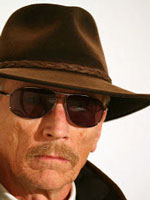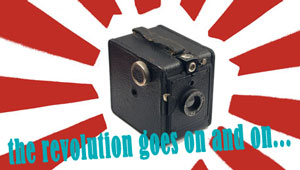
Photography is no longer a matter of preserving the visual image of an important person, or even about preserving the wedding day or the evolution of a newborn into and through childhood. Nor is it a matter of taking a picture of a friend, but rather a picture of ”now” as instant feedback and a check of appearance conformance and visual compliance. For many, photography has become a way of confirming the visual correctness of the moment. Photography has replaced the old powder mirror.
Yesterday I climbed a high point in the city of Stockholm taking advantage of the clear, crisp and sunny day to shot some panoramas. Several other people did the same, many using iPhones or equivalent. A young girl broke the pattern by photographing herself, arms lengths distance, with the safety bars, blue sky and possibly a sliver of out of focus city five miles off in the background.
While I focused on the city, she focused on herself. Possibly was she teleporting her moment to a friend. However, her apparent indifference to the people around her gave me the impression that her photography was rather a way to keep herself within her own little bubble, and the pictures are probably never to be shown to or seen by anybody else.
Just as you see “friends” sitting on a wall, each of them with a smartphone connected to somebody out of sight, or turning pages on the Internet, the camera phone has become a therapeutic device like a pacifier or baby blanket that occupies fingers and minds to let us forget about people around us, feeling out of place, worrying about being starred at or threatened in any way.
So no wonder that we can argue forever about the virtues of different cameras, like the appropriate size, weight and resolution. Since a camera is a pacifier to some, a powder mirror to others and a machine to make competition photographs for a few, the camera specification debate is meaningless.

In the pursuit of this I can see several missing photographic components.
Inch for inch digital image sensors have long passed the image quality and resolution of film.
Digital image sensors have also passed the image quality available from the lenses that we have learned to cherish. Some people think that older lenses lacking modern optical materials and coatings possess a magic ability to outshine modern lenses. I have never seen an image sample that proves this, but the romance and the claims live on.
Camera manufacturers have lately been competing to produce the smallest possible camera. Well, the camera phones have already won that battle and they will most likely continue to strive for an acceptable image quality. This is probably why investments in miniaturization like the Sony RX1 has not gone over that well, in spite of offering decent image quality.
I believe that there are people who want to be able to take a documentary picture when called for and do not care what they look like when they do. These people carry camera phones.
Then there are people who like taking pictures and who like carrying a camera which shows that they do it in style. I believe that these people want to be seen carrying a “real” camera, preferably light and nimble, but real and respectable looking. The signature of a real camera has so far been the DSLR. Olympus has figured this out, therefore the appearance of the OM-D E-M1. I think that insight is going to pay off for Olympus.
The Achilles heal of the industry is today the lenses. The leaders of the industry, Canon and Nikon, produce both cameras and lenses. I think that is key to staying on top of the industry. The rest, who only produce one or the other are always going to be minority, curiosity or accessory producers.
But even the big two today have problems in the lens department. Nikons top camera resolves 36 MP but their best lens resolves “only” 28MP. Their more common and affordable lenses resolve only a fraction thereof. Don’t forget that the weakest link in the chain determines the image quality. While Nikons best camera and lens represents a 28MP system, Canon’s best combo stops at 22MP.
Many experienced photographers argue that high resolution cameras are a waste of time. In a way they are right, a 12MP lens makes a 36MP camera seem like a waste of time since you get comparable results with a 24, or even a 16MP camera.
The problem is particularly acute in the area of long focal length lenses. A lens that weighs over 10 lbs and costs over $9,000 is not a practical solution for most photographers.
While I am a believer in maximizing megapixels and thereby image sensor size for landscapes, cityscapes and other busy scenes, there is a strong reason to think otherwise for super tele photography. Especially when the target is of limited size and can be fully depicted using less MP and a smaller image sensor.
I am presently searching for a camera with a small image sensor, maybe a Micro Four Thirds or smaller with a minimum of 12MP. The point is an image sensor resulting in a linear cropping factor at or below 1/2 in comparison to the image coverage of a full-frame lens.
The result is a full screen image that compares to that of a full-frame system with twice the focal length. I envision a Micro Four Thirds with or without an adapter and with a stellar 200 or 300mm prime lens producing the equivalence of a 400 or 600mm full-frame shot. If anybody knows of suitable components to do this I will be all ears.
A teleconverter as part of a full-frame setup is of course another but slower, heavier and more expensive way to accomplish a somewhat similar result.
If I had my way, teleconverters would mount on front of the lens, like a filter, as opposed to between the lens and the camera. This would eliminate breaking open the optical path in the field and would facilitate the design of large aperture teleconverters that would not diminish the speed of the primary lens.
Like I said, the photographic revolution is bound to continue with fun and exciting new options in the future.
Happy shooting !


